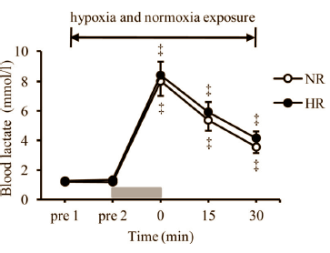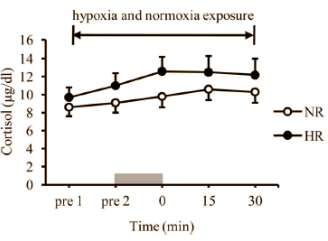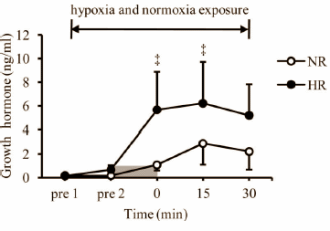Previous studies have shown that low-intensity resistance exercises with vascular occlusion and slow movement effectively increase muscular size and strength. Researchers have speculated that local hypoxia by occlusion and slow movement may contribute to such adaptations via promoting anabolic hormone secretions by the local accumulation of metabolites. In this study, we determined the effects of low-intensity resistance exercise under acute systemic hypoxia on metabolic and hormonal responses. Eight male subjects participated in 2 experimental trials: (a) low-intensity resistance exercise while breathing normoxic air (normoxic resistance exercise [NR]), (b) low-intensity resistance exercise while breathing 13% oxygen (hypoxic resistance exercise [HR]). The resistance exercises (bench press and leg press) consisted of 14 repetitions for 5 sets at 50% of maximum strength with 1 minute of rest between sets. Blood lactate (LA), serum growth hormone (GH), norepinephrine (NE), testosterone, and cortisol concentrations were measured before normoxia and hypoxia exposures; 15 minutes after the exposures; and at 0, 15, and 30 minutes after the exercises. The LA levels significantly increased after exercises in both trials (p ≤ 0.05). The area under the curve for LA after exercises was significantly higher in the HR trial than in the NR trial (p ≤ 0.05). The GH significantly increased only after the HR trial (p ≤ 0.05). The NE and testosterone significantly increased after the exercises in both trials (p ≤ 0.05). Cortisol did not significantly change in both trials. These results suggest that low-intensity resistance exercise in the hypoxic condition caused greater metabolic and hormonal responses than that in the normoxic condition. Coaches may consider low-intensity resistance exercise under systemic hypoxia as a potential training method for athletes who need to maintain muscle mass and strength during the long in-season.


